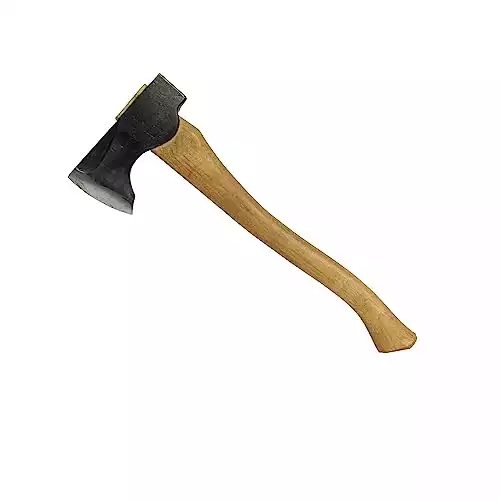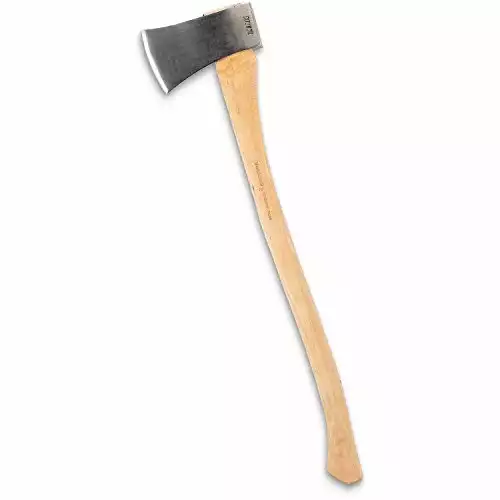
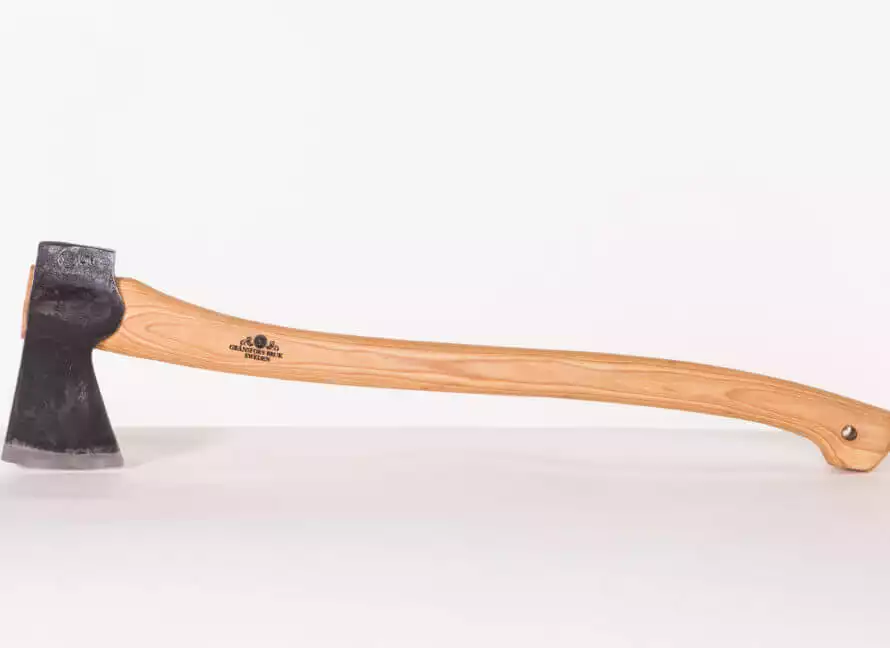
A bushcraft axe is an incredibly versatile tool in bushcraft and survival scenarios. When finely sharpened and properly hung, it can effortlessly perform a multitude of tasks. A bushcraft axe will quickly transform logs into manageable pieces for building shelters or making a fire. You can clear brush from camp or cut bows for a makeshift bed.
Unfortunately, the market has seen a decline in brands producing high-quality bushcraft axes. Choices in terms of axe length, weight, and head profile have become scarce.
So, we’ve decided to dig into the options and find the best bushcraft axes. Here they are, as well as info on how to make the right choice.
Best Bushcraft Axe – Quick Picks
What Type of Axe Is Best for Bushcraft?
There are a lot of different types of axes. Which type is “best” is debatable since bushcraft can mean so many different things. However, a felling axe or forest axe is probably the best choice for bushcraft.
Both of these axes have thin profiles and are designed to cut against the grain, making them ideal for felling standing trees and limbing branches. Dayton axe or bearded axe can also be good choices. More on the types of bushcraft axes in the buying guide below.
Note: Felling and forest axes are NOT good for chopping logs into firewood. For this, you will need a splitting axe. These have wider, heavier heads that cut with the grain. If you are a serious outdoorsperson, you’ll eventually need multiple types of axes.
Bushcraft Axe – Comparison Table
The Best Bushcraft Axes
Best Overall
Gransfors Bruk Scandinavian Forest Axe
Gransfors Bruk is famous for its high quality, and you won’t be disappointed. They even offer a 20 year guarantee on their axes.
It has a felling blade profile, which is quite thin. You won’t want to use this for splitting firewood, but the axe is versatile for bushcraft tasks and ideal for limbing trees. Do note, though, that Gransfors Bruk uses a modified carbon steel, which has a hardness of around 57 RC.
One benefit of low hardness steel is that it isn’t as brittle in wintertime. But soft steel axes aren’t as good for hardwood trees. It will still chop through hardwood, but you’ll need to sharpen it more frequently.
Weight:
2.6lbs
Length:
25″
Head weight:
1.6lbs
Cutting edge:
3.5”
Head material:
Ovako Steel
Made In:
Sweden
Warranty:
20 years
- Incredible craftsmanship
- Well-balanced
- Leather sheath
- Hand forged
- High-grade hickory handle
- Great warranty
- Expensive
- Low Rockwell hardness
Best Compact Bushcraft Axe
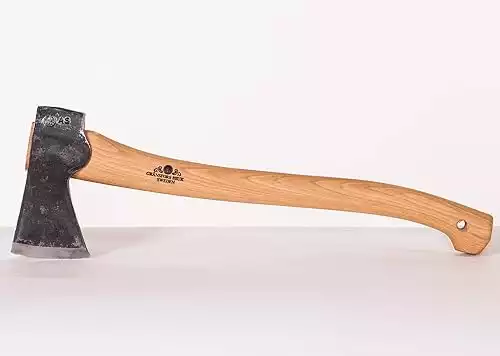
Gransfors Bruks Small Forest Axe 19 Inch
Here is another great bushcraft axe by Gransfors Bruk. It has a similar profile to the Scandinavian Forest Axe, but is smaller and more compact. Choose this one if you only have light camp tasks to perform and you have enough experience to operate an axe one-handed!
Head weight:
1.5lbs
Weight:
2lbs
Length:
19
Cutting edge:
3025
Head material:
Ovako Steel
Made In:
Sweden
Warranty:
20 Years
- Incredible craftsmanship
- Leather sheath
- Hand forged
- High-grade hickory handle
- Great warranty
- Expensive
- Low Rockwell hardness
Runner Up
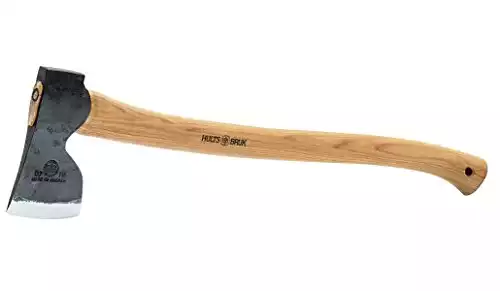
Hults Bruk Akka Foresters Premium Outdoor Axe
Hults Bruk is a longtime rival of Gransfors Bruk (bruk means mill in Swedish). The companies are almost identical when it comes to quality, though some will claim that GB has better quality control than HB. Even their steel has a similar hardness.
The main difference between the two companies is that HB has thicker handles, which people with large hands may prefer. HB axes are also usually a bit cheaper than similar models of GB axes. This isn’t a reflection of quality per se, but rather because GB hit the US market first and has a cult-like following, which is willing to pay more.
Head weight:
1.5lbs
Weight:
2.2lbs
Length:
24″
Cutting edge:
3.125”
Head material:
HB #3
Made In:
Sweden
Warranty:
Limited lifetime
- Incredible quality
- Leather sheath
- Hand forged
- High-grade hickory handle
- Great warranty
Best for Heavy Tasks
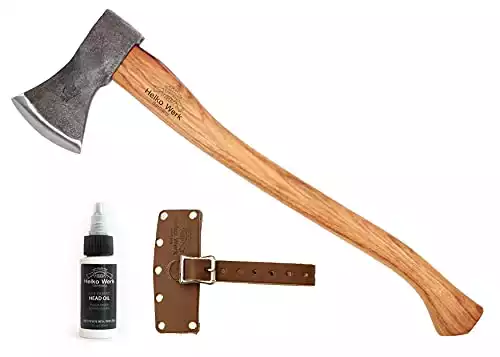
Helko Werk Germany Traditional Black Forest Axe
Helko Werk doesn’t get nearly as much attention as Gransfors or Hults Bruk. However, the quality of these German-made axes is just as good. The Helko sheaths are actually even better. I love that Helko is very transparent about the materials they use whereas HB can be a bit vague. The main complaint from users is that the quality control of Helko axes isn’t as good as with Gransfors.
The Helko Werk makes a lot of axes for heavy-duty use. Their Black Forest axe is one of their lighter models (but still the heftiest axe reviewed here). It is a good balance between weight and power for doing a variety of camp chores.
The head has a nice thin profile with a wide eye that cuts like a dream. You’ll have no problem felling small trees and can even use it for some splitting. The head is made from C50 high carbon steel with an RC of 53-56. All the HW heads are drop forged. Don’t be surprised if you convert to HW after trying this out.
Head weight:
2.25lbs
Weight:
3.5lbs
Length:
24″
Cutting edge:
3.5”
Head material:
C50 high carbon steel
Made In:
Germany
Warranty:
5 years
- Fantastic leather sheath
- Well-balanced
- Pricey
- Quality control not as good as with GB
Budget Swedish Made

Husqvarna 26″ Wooden Multi-Purpose Axe
Husqvarna axes are the “value” brand of Swedish axes. Even though many Husqvarna products are now apparently made in China, this multi-purpose axe is still Swedish made.
There are many good things about this chopper – like how it maintains sharpness well, has a handle long enough for safe beginner use, and is versatile.
Overall, it is a decent balance between quality and budget.
For the low price, though, you can’t expect it to be perfect.
There are some reported issues with the axe head breaking in half – even with proper usage.
The handle is hickory but low-grade hickory with wide grain. This means that the handle could also break on you. Overall, it’s not the best choice for hardwoods.
Head weight:
1.9lbs
Weight:
3lbs
Length:
26
Head material:
Not specified
Made In:
Sweden
Warranty:
90 Days
- Great value
- Retains edge well
- Long handle is better for beginners
- Leather scabbard
- Users report issues with head breaking
- Low-quality hickory handle
- Handle will shrink in warm climates
- Type of steel not given
Budget Pick
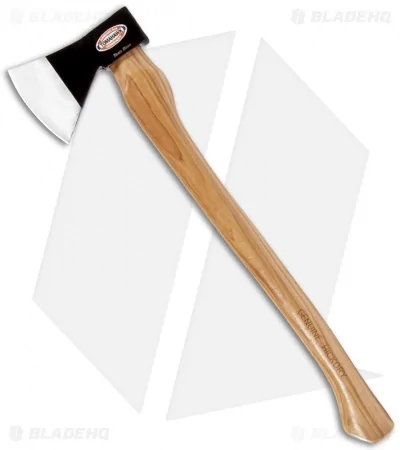
Cold Steel Trail Boss Axe
I had to include the Cold Steel Trail Boss in our list primarily because of its low price. As you’d expect for such a cheap tool, it doesn’t come close to the quality of the Swedish-made and Council Tool axes.
For a cheap product, though, it holds up surprisingly well.
The head doesn’t come loose. The handle doesn’t break (though some report it cracks when you hit a knot in hardwood). The head even holds up when you miss a few swings.
Note that the blade edge on the Trail Boss axe is very long, yet the head is still fairly lightweight. I wouldn’t want to use this on hardwoods or seasoning woods.
Also note that the head rusts easily. You will need to keep oil on it to protect it.
Still, it is pretty impressive for such a cheap tool.
Head weight:
1.8lbs
Weight:
2.6lbs
Length:
26″
Cutting edge:
4.5”
Head material:
1055 steel
Made In:
Taiwan
Warranty:
Limited lifetime
- Great for beginners
- Very affordable
- Comfortable handle
- Grade-A hickory handle
- Poor quality control
- No sheath
- Rusts easily
- Still a cheap product – it won’t hold up for serious work
Choosing a Bushcraft Axe
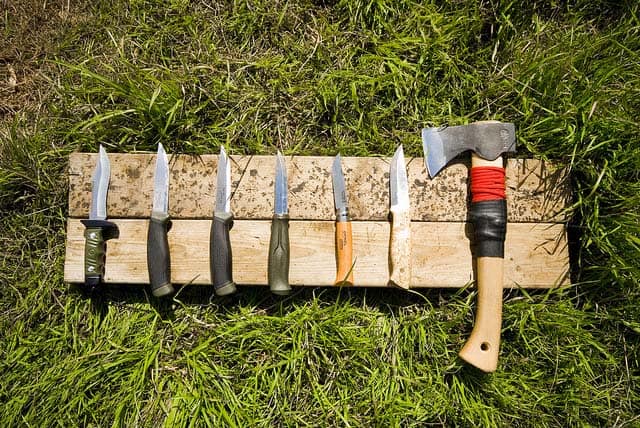
How Will You Use the Axe?
As mentioned before, a felling axe or forest axe is probably best for bushcraft. However, depending on the types of tasks you do, a different type of axe may be better.
Felling Axe:
- Characteristics: Thin blade with long, rounded cutting edge for making deep, clean cuts across the grain; Usually fairly heavy head with longer handle.
- Uses: Felling trees; limbing; chopping kindling
Forest Axe
- Characteristics: Usually smaller and lighter than a felling axe; blade is also narrow and designed for cutting against the grain but has a broader blade which is slightly curved or straight
- Uses: Versatile axe for camp tasks like limbing and chopping; also splits against the grain, so not ideal for splitting
Splitting Axe:
- Characteristics: Has a wide, wedge-shaped head for splitting wood along the grain and pushing fibers apart without the blade getting stuck
- Uses: Primarily for chopping felled trees; not very versatile
Boy’s Axe:
- Characteristics: Medium-sized axe which can be used with one or two hands; it is bigger than a hatchet but smaller than a felling axe
- Uses: Versatile axe for camp tasks like limbing, chopping small firewood and kindling
Broad Axe:
- Characteristics: Heavy head with a wide, flat blade and a long axe handle
- Uses: Shaping and hewing timber
*Most outdoors people don’t have just one axe. Whatever you end up choosing, consider it your “first axe.”
You’ll soon have at least one other, so you can take the tool best suited for the tasks you will be doing in the bush.
Handle Length
Full-length axes usually have handles of at least 32 inches to give you swinging power. However, this length is overkill for most bushcraft uses. A bushcraft camp axe is usually just up to 24 inches.
The shorter length makes the axe easier to carry (especially if attached to a pack) and also easier to maneuver in tight spaces.
What length is right for you?
The right axe length for a 5 foot tall woman (like myself) won’t be the same as for a 6 foot tall burly man. The length should be in balance with your body.
There are a few ways to measure the ideal axe length. The image below shows the most common ways to find the best length.
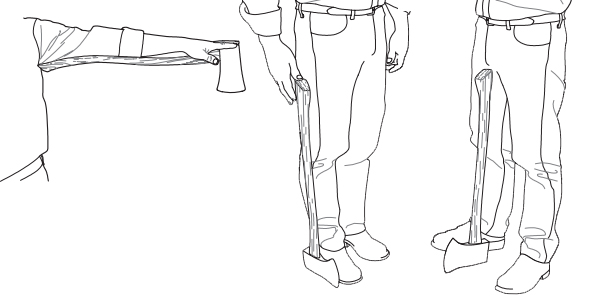
Don’t forget to consider how you will carry the bushcraft axe. You want to make sure it will fit in or on your bushcraft backpack!
Warning: Avoid Hatchets and Small Axes!
Many beginners make the mistake of choosing a hatchet or short axe as their first axe.
Short axes are bad choices because they:
- Are dangerous. The follow-through zone of a hatchet or short axe is the thighs and knees, thus making them much more dangerous than an axe with a long handle.
- Require more energy to use. This can be tiresome for beginners who haven’t mastered their swing yet.
- Are used one-handed. This takes skill to master, which means you risk injuring yourself or wasting injury on improper cuts.
If you are a beginner, then I’d recommend getting a full-length axe or a ¾ axe. They will be heavier to carry but are much safer to use. You’ll also be able to perform more tasks with the longer axes.
Head Weight
Note: Anything less than a 2-2 ½ pound axe is too light for serious work
An axe works by using the weight of the bit to cut through wood. The heavier the axe bit, the better it will cut through wood.
The tradeoff is that you will work a lot slower with a heavy chopper. If you haven’t mastered your swing and often miss the mark, then you’ll quickly become fatigued.
Because of these issues, lighter bushcraft axes tend to be the most popular. For example, the Gransfors Bruks Small Forest Axe (reviewed here) has a 2lbs head weight. They are more comfortable for beginners to master the swing with and easier to carry in a pack.
The compromise? A three-quarter axe (18-28 inch handle) weighing 2.5 to 3 pounds total is a good choice for beginners. It’s heavy enough for some serious work but light enough that you won’t become fatigued quickly or hurt yourself if you miss.
Head Profile
Axe heads vary in their thickness, shape, angle, grind, butt width, cheek contour… This is known as the head profile or pattern.
It used to be that you could find hundreds of different head profiles for axes. Now, most manufacturers only make a few head profiles. It’s rare for the manufacturers to even list which head profile they use (and you can’t see the subtle differences in photos!). If you have a preference, you will probably be out of luck.
Almost all of the bushcraft axes reviewed here have American felling axe profiles. However, there is also a bearded and Dayton-style head too.
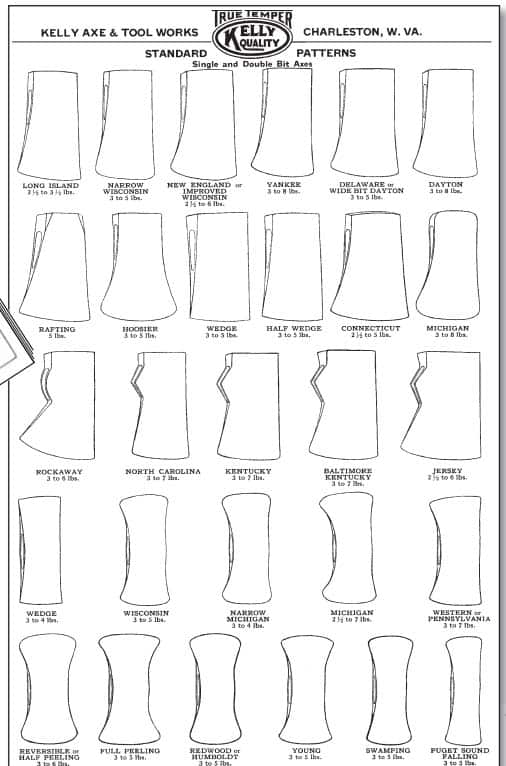
Single Bit or Double Bit?
While it might be tempting to get a double bit axe, they aren’t recommended for bushcraft. The main reason is because you won’t be able to use the butt (aka poll) of the axe.
Now, it’s not exactly smart to use your axe as a hammer. Only the bit of the axe is made from hardened steel and the rest is soft (this is to prevent the axe from breaking from impact). If you hammer with the axe, it can cause the eye to lose its shape and make the handle come loose.
But there are still a lot of times when you’d want to use the butt of your axe. For example, it’s often more efficient to gather dead pine branches by knocking them with the butt of your axe instead of chopping them. You also may need to hammer in wooden stakes or hit wedges.
Handle Material
When it comes to axe handle material, hickory wood is a favored choice for its exceptional combination of strength, shock absorption, and flexibility.
Ashwood is another popular option, known for its strength and durability, often preferred for its lightweight feel. Exotic hardwoods like hickory and oak also offer remarkable resilience.
Modern materials like fiberglass and composite materials are increasingly used for their durability and resistance to weathering, though traditionalists tend to prefer wood handles.
Grain Direction
The grain on the handle is just as important as the type of wood used. The grain should run in the same direction as the blade bit.
Good axe manufacturers will carefully choose the pieces of wood they use for their handles, avoiding ones that have knots, as these can become fracture points.
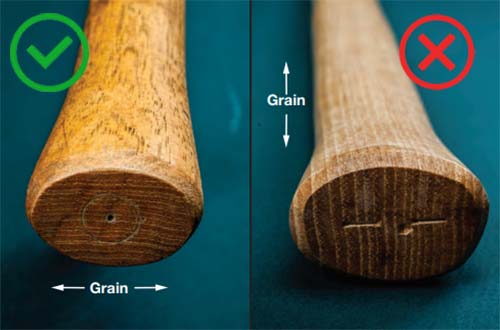
Hanging an Old Axe Head
Good axes are EXPENSIVE. One solution is to find an old axe head instead. They can often be found at estate sales or flea markets. Then you clean it up and put a new handle on it.
The process is called hanging an axe.
Fun fact: The phrase “get the hang of it” actually comes from hanging an axe. After hanging an axe so many times, you’d finally understand how to position the handle just right.
Hanging an axe is surprisingly difficult. Not only do you need to clean, profile and sharpen the axe head, but you also need to do prepare the eye so the handle fits and is aligned perfectly.
After trying this yourself – which will probably take at least 10 hours on your first try – you’ll realize that those quality axes might not be overpriced after all.
I’m not trying to dissuade you from hanging an old axe. But just be realistic about how much time you want to invest in learning this skill.
5. Best Axe Manufacturers
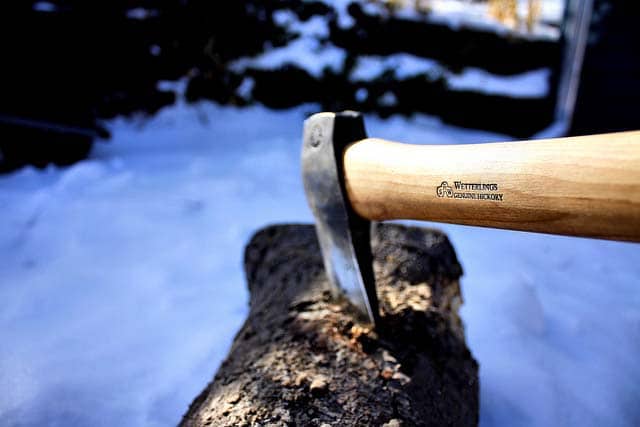
Please do not buy a cheap tool made by no-name Chinese manufacturers! These axes are of untested quality. You could end up severely injuring yourself when the bit goes flying off.
And any money saved by buying a cheap axe will just be negated when you have to replace the handle frequently.
Instead, choose one of the better-known axe manufacturers. These axes will cost more initially but will hold up through the test of time.
- Gransfors Bruks: These Swedish axes are frequently listed as the best. They go through a rigorous quality control process.
- Hults Bruk: The main competitor of Gransfos Bruks.
- SA Wetterlings: These are now owned by Gransfors Bruks.
- 1844 Helko Werk: An often-overlooked German axe brand that makes wonderful products.
- Council Tool: This is one of my favorite manufacturers. They are based in the USA and offer a variety of designs. They also do a great job of heat-treating their axes.
- Fiskars: This brand makes a lot of high-quality tools. Most of their axes are for splitting wood and not the felling type, which is better for bushcraft.
- Barco: This American company makes very high-quality products at a good value. Many of their axes come unfinished – you will have to grind them yourself.
- Husqvarna: Large, well-known manufacturer. Their products vary in quality and price but are generally good value.
What’s your favorite bushcraft axe? Let us know in the comments!


